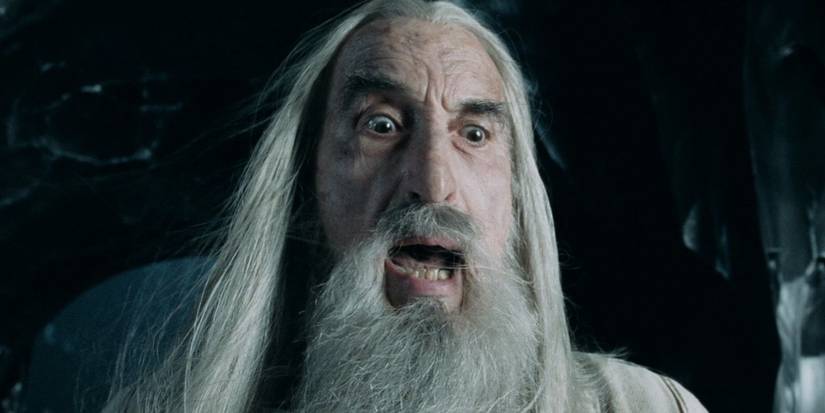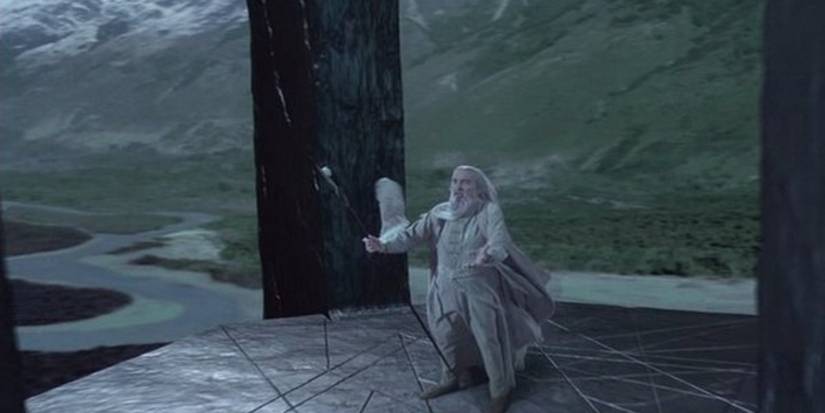There’s one chapter in The Lord of the Rings that I wish were in the movies, more than any other. Peter Jackson’s The Lord of the Rings films are some of the best fantasy movies out there, as well as some of the greatest and most faithful book adaptations ever made. That said, there are components of the books that are missing, and it’s worth exploring further.
The late great Sir Christopher Lee is one of my favorite performers of all time, and while I have nothing but love and admiration for his portrayal of Saruman, I find that Peter Jackson’s depiction of the character is somewhat reductive of the fascinating figure we see in J.R.R. Tolkien’s novels. Saruman makes for an exceptional movie villain, but he’s robbed of some of his most compelling qualities, much of which is due to the opaque nature of his depiction, differing from Tolkien’s mystical approach.
“The Voice of Saruman” Is One of ‘The Lord of the Rings’s Greatest Chapters
I’ve seen a million posts online about how The Return of the King missed out on “The Scouring of the Shire,” and while I agree this anticlimax is an excellent part of Tolkien’s books, I’m favorable to another magnificent Saruman chapter: “The Voice of Saruman.” This is the tenth chapter of The Two Towers, and it occurs after the Battle of Helm’s Deep, when Gandalf leads the heroes to Orthanc to plead with Saruman, giving the disgraced wizard a final chance at redemption.
Gandalf warns his companions of Saruman’s “voice,” a tool that can be used for immense, inexplicable power, as the wizard attempts to wiggle his way out of his imminent defeat. Sure enough, when Théoden marches forward and meets the man who’s terrorized his kingdom, Saruman presents himself as a kindly, innocent older man, nearly swaying Théoden to his side. Below is a brief excerpt from Tolkien’s description of Saruman’s voice, which perfectly captures the feeling of the scene:
“Those who listened unwarily to that voice could seldom report the words that they heard; and if they did, they wondered, for little power remained in them. Mostly they remembered only that it was a delight to hear the voice speaking, all that it said seemed wise and reasonable, and desire awoke in them by swift agreement to seem wise themselves.”
Saruman and Théoden engage in conversation, with Gandalf patiently waiting. Rather than intervene, Gandalf knows that he must let Théoden come to his own decision, to trust Saruman and be his friend, or to come to his senses and reject the manipulative wizard. Of course, the wise king chooses the latter, and Saruman’s tone instantly shifts from gentle sweetness to vile, decrepit spite, lashing out at his foes:
“What is the house of Eorl but a thatched barn where brigands drink in the reek, and their brats roll on the floor among the dogs?” Too long have they escaped the gibbet themselves. But the noose comes, slow in the drawing, tight and hard in the end. Hang if you will!… I know not why I have had the patience to speak to you.”
The tone shift here is outstanding. Not only have we seen the manipulative aspect of Saruman’s voice, which beckons people in and compels their hearts to listen to him, but we’re also seeing the voice’s capacity for destruction. This is a noise that oozes evil and corruption; a voice that commands orcs and longs for the One Ring, yet is amplified by the powers of a learned magical being.
Next, Gandalf does something else that doesn’t occur in the films: he offers Saruman a chance to turn back, to forsake his evil deeds and join the forces of the light against Sauron. It’s too late, however, as Saruman is much too prideful and angered by his defeat at the Fellowship’s hands. Gandalf uses his power to shatter Saruman’s staff, eliminating the wizard’s symbolic tool of magic and power, and ending one of the primary threats in The Lord of the Rings.
Part of what makes this chapter so compelling is that Tolkien’s villains are phantom threats throughout the saga. Sauron, in particular, doesn’t actually appear, and the Witch King becomes the vessel for his forces. This makes Saruman’s singular appearance in this chapter all the more compelling, as it’s the only straightforward glimpse readers get at the beings spreading so much terror in Middle-earth. This is the shadow, or how Tolkien personifies it.
How Saruman Differs From ‘The Lord of the Rings’ Books to Films
Magic is characterized in an interesting way in Peter Jackson’s The Lord of the Rings films, offering much of the vague, supernatural obscurity it does in the books. Tolkien writes magic in a mysterious way; it’s not mechanical, like it would be in a Brandon Sanderson novel. This makes it all the more disappointing that Saruman, one of the chief representatives of this facet, is a fairly straightforward villain in the movies.
Through the growing strength of Isengard in The Fellowship of the Ring and The Two Towers, audiences get to see the power of Saruman. However, this depiction lacks the nuance of his skill set. Audiences see what he achieves, but they don’t see how he’s able to achieve it. They don’t see the cunning wizard who persuaded the Rohirrim to give him Isengard in the first place, or the crafty, deceptive villain who could nearly persuade Théoden to be pals after the atrocities committed in Rohan.
The only scene that really shows the power of Saruman in a way that’s in tune with his book counterpart is when the Fellowship attempts to cross Caradhras. Saruman, atop the tower of Orthanc, projects his booming voice onto the wind, causing an avalanche from many miles away. Legolas immediately detects the “fell voice” in the air, which carries an elemental evil to crush their travels.
We see Grima Wormtongue’s manipulation, but Saruman himself is never given an opportunity to show his true strength. He tries to sway Gandalf toward the shadow in The Fellowship of the Ring, but it’s so evident that he’s evil that they engage in a physical battle, not the test of wits and mental fortitude exhibited in “The Voice of Saruman.”
With all that being said, I still haven’t even mentioned his treatment in The Return of the King, where Grima Wormtongue stabs him in the back atop Orthanc. This abridged adaptation of “The Voice of Saruman” didn’t even make it into the theatrical cut of The Lord of the Rings trilogy, which tells viewers exactly what they need to know about the depiction of one of Tolkien’s greatest characters. Don’t get me wrong, I love those movies as much as anyone, but there are elements of literature that film can’t always provide.


